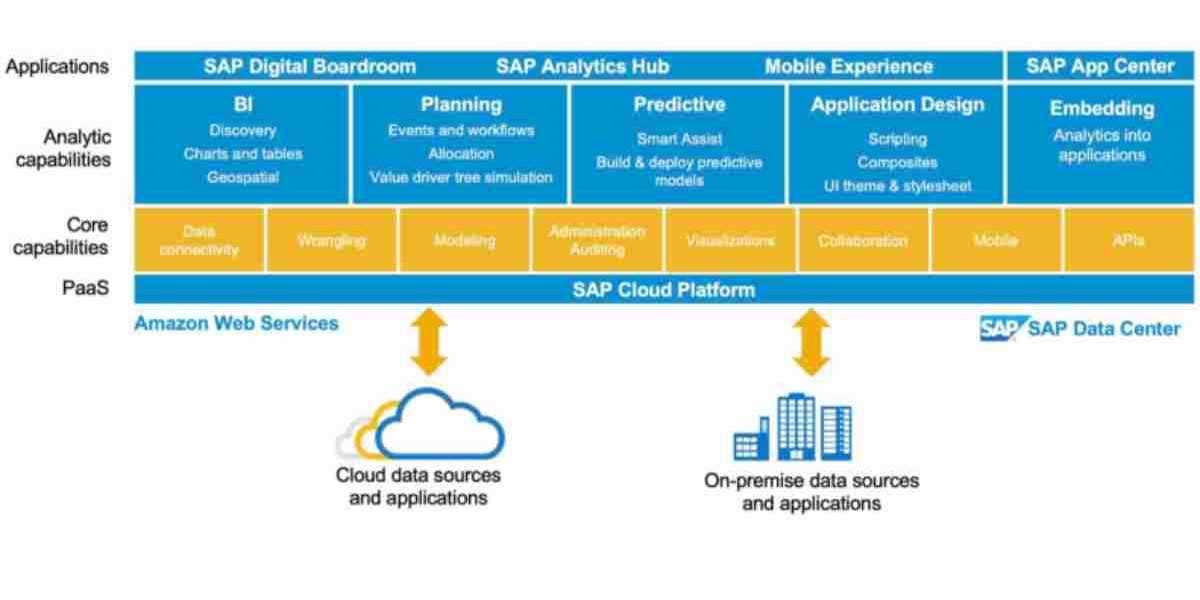In today’s data-driven world, businesses are increasingly focused on leveraging vast amounts of data to gain actionable insights and drive smarter decision-making. SAP Analytics Cloud (SAC) stands out as a robust solution designed to meet these needs, offering a comprehensive suite of business intelligence, augmented analytics, and planning capabilities in a single cloud-based platform. This blog explores the key features and benefits of SAP Analytics Cloud and how it can transform your data analytics strategy.
SAP Analytics Cloud is an enterprise analytics solution within the SAP Business Technology Platform (BTP). It integrates planning, predictive analytics, and business intelligence into a unified workflow, connecting to a wide range of data sources both on-premises and in the cloud. This integration allows for a holistic view of organizational data, facilitating more informed decision-making. SAC supports data from various sources, including SAP systems like SAP BW and SAP HANA, as well as non-SAP applications such as Google BigQuery and SQL databases. Users can connect to these sources either through live connections, which provide real-time data access, or data acquisition, which involves replicating data into SAC.
The architecture of SAC comprises three key layers. The core layer includes the SAP HANA database and the SAC application server, forming the foundation of the platform. The data layer connects SAC to various data sources, whether hosted on SAP’s data centers, on-premises, or in a hybrid environment. The user layer offers access through the SAC web application, mobile app, and SDK, ensuring that users can interact with the platform from any device with a web browser.
One of the standout features of SAC is its data integration capability. It allows seamless consolidation of data from disparate sources, including spreadsheets, databases, and cloud applications. The SAP Analytics Cloud Modeler is a powerful tool for preparing, transforming, and modeling data, while the integration with SAP S/4HANA Cloud supports comprehensive planning and reporting objectives. Additionally, SAC’s integration with Microsoft Office through an add-in enhances data accessibility and manipulation within Excel.
SAC excels in data visualization with its intuitive drag-and-drop interface, which allows users to create engaging and interactive dashboards. It offers a diverse range of chart types, widgets, and formatting options to effectively present data. Beyond traditional business intelligence, SAC incorporates advanced analytics features, including predictive analytics, machine learning, and natural language processing. These capabilities enable users to uncover hidden patterns, perform forecasts, and make data-driven predictions.
Planning and budgeting are streamlined within SAC, simplifying financial processes and enhancing decision-making. The platform supports collaborative budget creation, what-if scenarios, and variance analysis, allowing stakeholders to work together on financial plans and align strategies using real-time data. Features such as smart predict and value driver trees help businesses explore various outcomes and compare them with actual results.
Collaboration and sharing are integral to SAC, fostering a data-driven decision-making culture. The platform facilitates real-time discussions, comments, and task assignments, making it easy for teams to collaborate on stories and reports. Users can annotate their work with text and media, and comment on data points to facilitate discussion and feedback.
Being a cloud-based solution, SAC offers accessibility and scalability, providing users with the flexibility to access data and analytics from anywhere. It eliminates the need for infrastructure maintenance and allows for scalable resource management. Additionally, SAC’s self-service analytics capabilities empower business users to create dashboards and reports without extensive IT involvement, enhancing agility and responsiveness.
SAC seamlessly integrates with other SAP products, such as SAP S/4HANA and SAP Data Warehouse Cloud, ensuring real-time data communication and leveraging existing SAP technology investments. Security and data governance are top priorities, with features such as role-based access control, data encryption, and compliance with industry standards like GDPR ensuring robust protection of sensitive data.
Recent updates to SAC include enhancements such as the unification of stories and analytic applications, support for running total calculations, and improved progress aggregation and concurrent editing. Upcoming features in future releases are set to enhance custom widget functionality, integrate SAP Data Sphere, and support more data connectors and dynamic visualizations.
In conclusion, SAP Analytics Cloud is a powerful and versatile platform that integrates analytics, planning, and business intelligence into a cohesive solution. It enables organizations to make confident, data-driven decisions with a user-friendly interface and comprehensive features. By leveraging SAC, businesses can transform their approach to data analytics, gain valuable insights, and stay ahead in a competitive landscape. Embrace SAP Analytics Cloud to unlock new opportunities and drive better business outcomes in today’s data-centric world.














